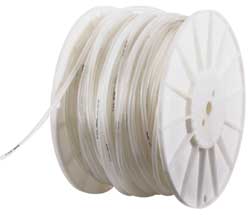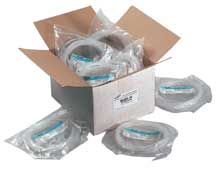Current GMPs: Added Assurance of Quality for Masterlex Tubing

With greater regulatory focus in the pharmaceutical industry, attention increasingly turns to the rationale for various guidelines, standards and specifications and their role as blueprints for producing quality products that perform a specific function and ensure safety. ISO standards provide a valuable framework for quality and function, yet they focus most closely on the end result, rather than on the entire manufacturing process. The implementation of current Good Manufacturing Practices (cGMPs) is an important complement to the successful production of tubing and other products for pharmaceutical applications. Selecting the appropriate level of cGMPs has been a vital component of the process.
This article describes how cGMPs guide the quality process in the health care manufacturing environment and how they relate to risk management from the perspective of patients. It also demonstrates an approach for evaluating various levels of current Good Manufacturing Practices (cGMPs) and relating them to the requirements for individual materials and applications. Incorporating cGMPs as an approach to the manufacturing of tubing for pharmaceutical applications reflects the difference in objectives between health care and industrial manufacturing environments. In the industrial environment, decision making is largely influenced by volume, cost reduction, physical property specifications and efficiency. In contrast, decision making in the health care environment is driven by fitness for use.
The Object of a Quality System: Patients
From the perspective of pharmaceutical manufacturers and their suppliers, quality is a vital issue that ultimately finds its way to patients. The concerns of patients and their families center on confidence that drugs are safe in terms of the identity, purity and dosage level intended by their manufacturer. Drug manufacturers gain an added measure of confidence and control if they are assured that suppliers throughout the manufacturing process consider their materials fit for use in health care applications. In its role as a material supplier, capitalizes on the benefits of bulk pharmaceutical cGMPs to ensure the highest quality products for our customers, who in turn translate that quality into the products that reach patients.
Table I summarizes some of the differences between pharmaceutical cGMP principles, which are the basis for manufacturing Masterflex 96410-series* platinum-cured silicone pump tubing, and ISO 9001 standards for industrial applications. Industrial silicones that claim USP Class VI testing typically fall into the latter category.
[*Masterflex 96410-series tubing includes 96510-series (same material, larger size), 96403-series (96410-series on spools), and 96404-series (96410-series in bulk packs)]
On the surface, the relationship between current Good Manufacturing Practices and other standards may appear redundant. For example, it would not be unusual for a manufacturing facility to question the value of cGMPs if it were already operating under a series of stringent standards. If a particular site were registered to ISO standards, it might appear that this would be sufficient evidence of attention to quality. In fact, ISO is currently a voluntary standard with only some relationship to the current laws and issues of regulatory compliance that form the basis of cGMPs and that result in penalties based on failure to comply.
The facility that produces Masterflex 96410-series platinum-cured silicone pump tubing has been registered to ISO 9001 since 1989. Until recently, ISO registration was not common in the health care industry, and only now are significant numbers of industry players beginning to evaluate its importance. As more of the health care industry turns to ISO registration, some facilities may be tempted to view cGMPs as unnecessary, and vice versa. Although a degree of overlap is evident between the two approaches, notable disparities occur in terms of issues and concerns.
While ISO standards are indeed the foundation for a good quality system, a documented method of demonstrating value to customers, and an efficient mode of doing business, there is no ramification other than potential breach of contract with a customer if the standard is not followed or upheld—and there is no penalty other than loss of business. In contrast, cGMPs translate issues of quality to a different plane; as enforced by the FDA, they occupy a position over and above ISO and different from ISO.
As Table I indicates, pharmaceutical cGMP principles ensure that even seemingly small steps are directed toward the overriding goal of quality for patients. In the manufacturing environment, excluding sick workers from the work force eliminates the potential for adding an undesirable bioburden to products. Controlling cleaning agents, equipment lubricants, and all forms of contamination ensures that traces of these materials cannot invade a finished product.
Completing checks on all raw materials gives added assurance of safety and quality, for although many chemicals function in a similar manner, they may have very different toxicology profiles. Each section of Table I demonstrates cGMP involvement throughout the manufacturing process, in addition to site and equipment maintenance, employee management and change evaluations.
TABLE I: Comparison of Pharmaceutical cGMP Principles and ISO 9001
| PHARMACEUTICAL cGMP Principles (Masterflex® 96410-series platinum-cured silicone pump tubing) |
INDUSTRIAL ISO 9001 |
|---|---|
| QUALITY | |
|
|
| CONTAMINATION AND EQUIPMENT | |
|
|
| MANUFACTURING PROCESS | |
|
|
The Hierarchy of cGMP Levels
Manufacturing according to cGMPs is a significant step toward quality improvement, but it is also crucial to focus on the appropriate level of cGMPs. The FDA outlines a variety of cGMP levels based on different products and applications. Bulk pharmaceutical cGMPs, which govern the manufacture of Masterflex 96410-series platinum-cured silicone pump tubing, focus on identity, strength, quality and purity.

The facility that produces Masterflex 96410-series platinum-cured silicone pump tubing is registered with the FDA and operates under pharmaceutical cGMP principles. This official registration with the FDA results in the agency inspecting the site for its adherence to the specific elements of a particular level of cGMPs (in this case, bulk pharmaceutical) as outlined by the agency.1 The decision to register with the FDA is a conscious one that carries consequences: if the agency finds areas that are not in compliance, the results may range from negative publicity to plant closure to criminal charges. For these reasons, a facility that claims "cGMP practices" may not choose to register with the FDA.
Customer Applications
In the case of products that are classified as drugs, articles used as components of these products also are classified as drugs. Just as the antihistamine in a cold medicine is viewed as a drug and must be manufactured under a specific set of cGMPs, the same is true of the food coloring, glycerin and propylene glycol used in the product. Manufacturers who do not produce these components according to cGMPs run a risk: the FDA prohibits "the introduction or delivery for introduction into interstate commerce of any food, drug, device or cosmetic that is adulterated or misbranded."2 While this definition may appear clear-cut, the definition of "adulterated" is crucial: "a drug shall be deemed to be adulterated...if it is a drug and the methods used in, or the facilities or controls used for its manufacture, processing, packaging, or holding do not conform with good manufacturing practice."3 Translated to the case of Masterflex 96410-series platinum-cured silicone pump tubing, the drug manufacturer who is using the tubing has the assurance that it is produced under the same GMP standards as the drug that is passing through it.
As developers of health care products evaluate suppliers, they will want to look for quality systems that combine the best of ISO or similar standards with a quality system that is attuned to factors that affect the finished product. For this reason, our quality system for Masterflex 96410-series platinum-cured silicone pump tubing is not based on ISO standards alone, but also on cGMPs.
Assessing Objectives
In the final analysis of cGMPs, perhaps the most telling evaluation comes from considering the difference between objectives in different manufacturing environments. In an industrial-based manufacturing environment, decision making is prompted by volume, cost reduction, physical property specifications and the elimination of wasted time. There may not be time to assess the impact of a material if it varies from lot to lot. In contrast, decision making in a company that has a quality system based on cGMPs is driven by fitness for use and overall appropriateness for health care applications.
Although ISO registration plays an important role in manufacturing quality, it is not the total quality solution for health care applications, for its standards rely on checks at the end of the process. With an entire quality system based on cGMPs, suppliers and manufacturers comply not only with the letter of the law, but also with the spirit of the regulations—and in the final analysis, this is quality designed for health care and for patients.
References
- Guide to Inspection of Bulk Pharmaceutical Chemicals (Sept 1991).
- Section 301(a) of the Federal Food, Drug and Cosmetic Act.
- Section 501 (a) (2) (B) of the Federal Food, Drug and Cosmetic Act.
Reprinted with permission of Dow Corning, Inc.